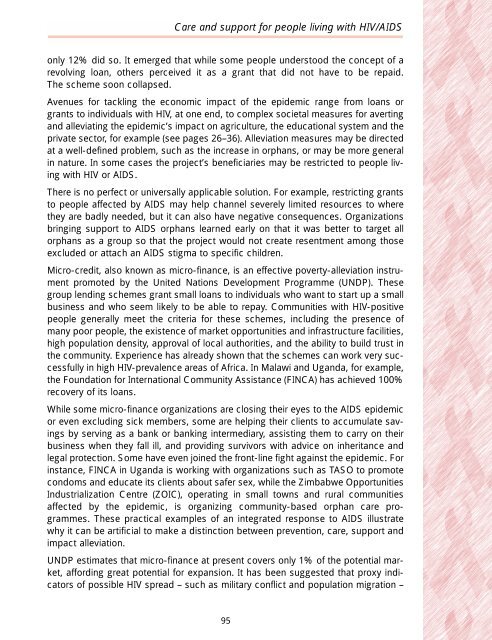Care and support for people living with HIV/AIDS
Care and support for people living with HIV/AIDS
Care and support for people living with HIV/AIDS
Create successful ePaper yourself
Turn your PDF publications into a flip-book with our unique Google optimized e-Paper software.
<strong>Care</strong> <strong>and</strong> <strong>support</strong> <strong>for</strong> <strong>people</strong> <strong>living</strong> <strong>with</strong> <strong>HIV</strong>/<strong>AIDS</strong>only 12% did so. It emerged that while some <strong>people</strong> understood the concept of arevolving loan, others perceived it as a grant that did not have to be repaid.The scheme soon collapsed.Avenues <strong>for</strong> tackling the economic impact of the epidemic range from loans orgrants to individuals <strong>with</strong> <strong>HIV</strong>, at one end, to complex societal measures <strong>for</strong> averting<strong>and</strong> alleviating the epidemic’s impact on agriculture, the educational system <strong>and</strong> theprivate sector, <strong>for</strong> example (see pages 26–36). Alleviation measures may be directedat a well-defined problem, such as the increase in orphans, or may be more generalin nature. In some cases the project’s beneficiaries may be restricted to <strong>people</strong> <strong>living</strong><strong>with</strong> <strong>HIV</strong> or <strong>AIDS</strong>.There is no perfect or universally applicable solution. For example, restricting grantsto <strong>people</strong> affected by <strong>AIDS</strong> may help channel severely limited resources to wherethey are badly needed, but it can also have negative consequences. Organizationsbringing <strong>support</strong> to <strong>AIDS</strong> orphans learned early on that it was better to target allorphans as a group so that the project would not create resentment among thoseexcluded or attach an <strong>AIDS</strong> stigma to specific children.Micro-credit, also known as micro-finance, is an effective poverty-alleviation instrumentpromoted by the United Nations Development Programme (UNDP). Thesegroup lending schemes grant small loans to individuals who want to start up a smallbusiness <strong>and</strong> who seem likely to be able to repay. Communities <strong>with</strong> <strong>HIV</strong>-positive<strong>people</strong> generally meet the criteria <strong>for</strong> these schemes, including the presence ofmany poor <strong>people</strong>, the existence of market opportunities <strong>and</strong> infrastructure facilities,high population density, approval of local authorities, <strong>and</strong> the ability to build trust inthe community. Experience has already shown that the schemes can work very successfullyin high <strong>HIV</strong>-prevalence areas of Africa. In Malawi <strong>and</strong> Ug<strong>and</strong>a, <strong>for</strong> example,the Foundation <strong>for</strong> International Community Assistance (FINCA) has achieved 100%recovery of its loans.While some micro-finance organizations are closing their eyes to the <strong>AIDS</strong> epidemicor even excluding sick members, some are helping their clients to accumulate savingsby serving as a bank or banking intermediary, assisting them to carry on theirbusiness when they fall ill, <strong>and</strong> providing survivors <strong>with</strong> advice on inheritance <strong>and</strong>legal protection. Some have even joined the front-line fight against the epidemic. Forinstance, FINCA in Ug<strong>and</strong>a is working <strong>with</strong> organizations such as TASO to promotecondoms <strong>and</strong> educate its clients about safer sex, while the Zimbabwe OpportunitiesIndustrialization Centre (ZOIC), operating in small towns <strong>and</strong> rural communitiesaffected by the epidemic, is organizing community-based orphan care programmes.These practical examples of an integrated response to <strong>AIDS</strong> illustratewhy it can be artificial to make a distinction between prevention, care, <strong>support</strong> <strong>and</strong>impact alleviation.UNDP estimates that micro-finance at present covers only 1% of the potential market,af<strong>for</strong>ding great potential <strong>for</strong> expansion. It has been suggested that proxy indicatorsof possible <strong>HIV</strong> spread – such as military conflict <strong>and</strong> population migration –95












